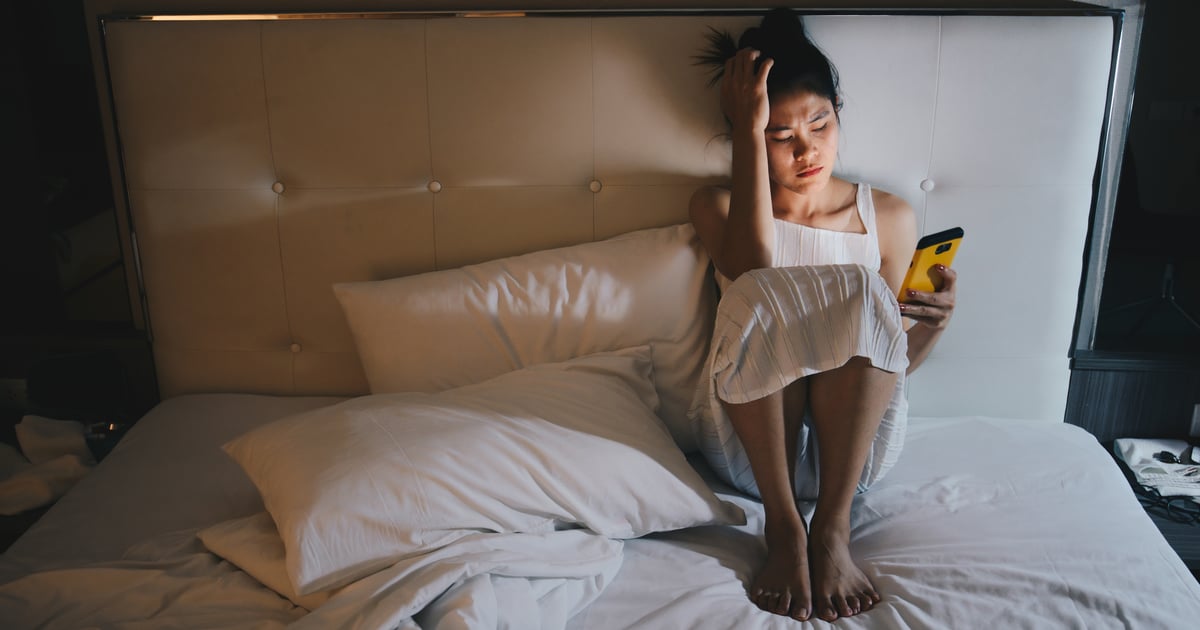Products You May Like

When tragedy strikes, many people turn to social media in an attempt to find the words they cannot come up with themselves. And after a month of turmoil — including the looming loss of abortion rights, the two-year anniversary of George Floyd’s death, and the deadliest elementary-school shooting since 2012 happening in Uvalde, TX — it’s likely people are staring helplessly into their phones now more than ever.
Whether you’re seeking comfort, distraction, or news updates, social media has a way of luring you in, especially during times of chaos. But while it’s important to stay informed about what’s happening in the world, psychologists say there is such a thing as consuming too much news — especially when it feels like you’re on a conveyor belt of bad news and can’t stop. This phenomenon is called “doomscrolling.”
“Doomscrolling refers to the rabbit holes we often find ourselves in on the internet, reading, searching, and ‘investigating’ the toils and troubles of the day,” Jason S. Moser, PhD, a professor of clinical psychology at Michigan State University, tells POPSUGAR.
Though it can occasionally bring people together in times of difficulty, social media rarely provides the “comfort” so many people seek at times like this. And even if you don’t want to stay off of Instagram, Twitter, or Facebook in fear of missing new information or updates on current events, this could be wreaking havoc on your mental health. Here’s how to find a balance, so you can stay informed but on your own terms.
What Is Doomscrolling?
Doomscrolling isn’t exactly a new concept, because people generally focus on bad news, Moser says — but thanks to our smart devices, we can now consume countless headlines and discussions on social media about these issues every second of the day.
As is the case with anything we do in excess, Moser says we generally reach a point where we’re not learning anything new and the time spent doomscrolling can begin to creep into other aspects of our lives. For example, if the amount of time you spend scrolling interferes with completing work tasks, caring for family, and socializing with friends, it’s a red flag that you need to change the behavior, Erika McElroy, PhD, a licensed psychologist at Aurora Mental Health Center in Aurora, CO, tells POPSUGAR.
“Doomscrolling is an interesting phenomenon because it’s a ‘reassurance seeking’ behavior,” Moser explains. “That is, we’re presumably looking for things to put our minds at ease — definitive information that helps us end the uncertainty or keep us in ‘the know’ or maybe even something good to offset the bad.” Unfortunately, there’s often not a definitive answer, so we can find ourselves in a cycle of looking for solutions and not finding anything, which only causes or exacerbates anxiety.
Moser notes that sometimes we do find a bit of relief, which only reinforces the behavior. “The momentary relief we find in some of these answers makes us more likely to scroll again,” he says. “The problem is, scrolling only has short-term benefits. Most likely it will result in longer-term anxiety and uncertainty because we never find the answer or relief that lasts that long.”
How to Stop Doomscrolling
Doomscrolling is a bad habit like not sleeping enough — and bad habits can be changed through awareness and making conscious choices, McElroy says. To break the habit, she recommends following these steps.
- First, figure out exactly how much time you spend doomscrolling. “[You] can start a simple tracking system that includes how often [you] read news and how much time [you] spend reading each time,” McElroy says, noting that most people aren’t aware of just how much time they spend scrolling each day. This simple task can be eye-opening. For a quick estimate, look at the screen-time report on your phone.
- Next, set a limit for how much time you want to spend scrolling through the news or social media each day. McElroy says this will vary depending on your habits. For example, some people read news a few times a day for short periods of time, while others scroll once a day for longer periods. “The important thing to consider is how you feel after reading and if you find yourself replaying what you read in your mind,” McElroy explains. “If you feel anxious and upset, that’s a cue that you probably need to reduce the amount of time reading news or possibly read the news less frequently.”
- Don’t scroll before bed, as that’s a time when your mind and body should be focused on getting rest. Doomscrolling “sends a continuous message to the brain that situations in life are unsafe,” McElroy explains, which can put your brain in “fight or flight” mode and cause physical symptoms of anxiety. Needless to say, putting your body into fight-or-flight mode right before bed can cause sleep disruptions.
- Balance the negative with a positive. “It can be helpful to plan a pleasant activity like a walk or talking with a friend after spending time reading negative news,” McElroy says. “This can help balance the negative information with a positive experience.”
- Take breaks from your phone and laptop. We’ve become accustomed to being connected to our devices at all times, but “the simple task of removing them from our environment can help remind a person to stop and think before engaging in doomscrolling behavior,” McElroy says.
- After you’ve taken steps to change your doomscrolling habits, do a weekly check-in with yourself. Assess how well you’re sticking to your new routine. For example, McElroy recommends asking yourself simple questions such as, “Am I spending more or less time scrolling than I would prefer?” and “How do I feel after making these changes?”
Of course, with the many tragedies that have happened over the last few months and years, it’s important to prioritize and take care of your mental health. For some, that may mean going on a social media break. For others, it could be limiting the amount of time you spend on social media. For additional help and resources, consider speaking to a mental health professional.
— Additional reporting by Taylor Andrews
If you are feeling anxious or depressed and need help finding help or resources, the Anxiety & Depression Association of America and the National Alliance on Mental Illness (1-800-950-6264) have resources available.
